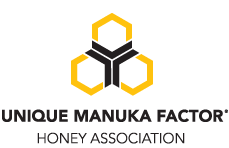Home >> Honey Articles >> UMF and MGO Ratings Explained
UMF vs MGO
Updated 15 May, 2013 by Aliveplushoney


UMF and MGO Ratings Explained
If you have been trying to assess the strength of Manuka Honey products, you may have noticed two different labels on the honey containers. One being UMF, the other MGO.
UMF is an internationally registered trademark that can be used only by licensed users who meet set criteria which include auditing and monitoring to ensure the product is natural, unadulterated, Manuka honey that has the unique non-peroxide antibacterial activity and is true-to-label claim.
Many different Manuka Honey producers use this system.
MGO ratings refer to the level of Methyglyoxal in the honey. Methyglyoxal is a marker of Manuka honey but it does not cause the non-peroxide activity. MGO™ is a trademark of Manuka Health New Zealand Ltd, and you will only see MGO labels on their own products.
All types of honey have a very mild antiseptic property because they contain hydrogen peroxide. It is only Manuka Honey that has the additional and more powerful antibacterial property.
Here is a quick outline of both UMF and MGO plus a summary:
UMF®
UMF is more established and widely used and it stands for 'Unique Manuka Factor'.
After Dr. Peter Molan, a Senior Lecturer at the Waikato University in New Zealand, discovered the additional antibacterial property in Manuka Honey, the UMF rating system was developed to measure the activity level of Manuka Honeys.
Rather than measuring the methylglyoxal content like the MGO methodology, the UMF rating actually tests the antibacterial performance of a honey and compares it to phenol, a disinfectant. The Active Manuka Honey Association(AMHA) that does the testing states:
"The presence of the special non-peroxide activity can be detected only by an array of scientific testing directly relating to the phenol standard. The rating has a one-to-one relationship to the phenol standard. "
This means that a UMF rating of 20+ is equivalent in strength to a 20% solution of phenol. Manuka Honey is independently tested in an accredited laboratory for its antibacterial UMF®. All Manuka Honey that has a UMF rating of more than 10 is highly active honey and therefore known as Active Manuka Honey. The ideal UMF rating varies depending on your purpose, but laboratory studies have shown that manuka honey with a non-peroxide activity level of UMF®12 to UMF®15 is effective against a wide range of very resistant bacteria.
MGO
The discovery of the active ingredient "Methylglyoxal" in Manuka Honey was made by Professor Thomas Henle from the Institute of Food Chemistry at the Technical University of Dresden in Germany. Manuka Health state that the higher the MGO™ rating in Manuka honey the higher the level of anti-bacterial activity in the honey.
Methylglyoxal is a compound found in the pollen of the Manuka tree's flowers. This tree, a New Zealand native has a short flowering period which makes the placement of hives and the timing of the harvest crucial. If done correctly, the Methylglyoxal present in the maunka honey will be much higher.
Summary of UMF vs MGO Manuka Honey
UMF and MGO ratings are both used to indicate the antibacterial strength of Manuka Honey.
UMF is the industry standard. MGO is only used by Manuka Health New Zealand Ltd.
UMF and MGO measure the strength of Manuka honey in different ways.
You can get more information and buy both UMF and MGO Manuka Honeys here.

